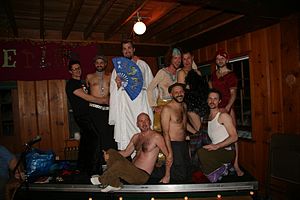
Information to change the world | |
Find Topics, Titles, Names related to your query |

Information to change the world | |
Find Topics, Titles, Names related to your query |
|
|
Radical Faeries
|
||||||||||||||||||||||||||||
| A major contributor to this article appears to have a close connection with its subject. It may require cleanup to comply with Wikipedia's content policies, particularly neutral point of view. Please discuss further on the talk page. (September 2009) |
| This article needs additional citations for verification. Please help improve this article by adding reliable references. Unsourced material may be challenged and removed. (August 2009) |

Radical Faeries (also Faeries and Faes) are a loosely affiliated worldwide network of people seeking to reject hetero-imitation and redefine queer identity through spirituality. The Radical Faerie movement started in the United States among gay men during the 1970s sexual and counterculture revolution.[1] The movement has expanded in tandem with the larger gay rights movement, challenging commercialization and patriarchal aspects of modern LGBT life while celebrating pagan constructs and rituals.[2] Faeries tend to be fiercely independent, anti-establishment, and community-focused.[2] Faerie culture is undefinable as a group; however, it has similar characteristics as "Marxism, feminism, paganism, Native American and New Age spirituality, anarchism, the mythopoetic men's movement, radical individualism, the therapeutic culture of self-fulfillment and self-actualization, earth-based movements in support of sustainable communities, spiritual solemnity coupled with a camp sensibility, gay liberation and drag." [3]
Radical Faeries today embody a wide range of genders, sexual orientations, and identities. Many sanctuaries and gatherings are open to all, while some still focus on the particular spiritual experience of man-loving men co-creating temporary autonomous zones.[4] Faerie sanctuaries adapt rural living and environmentally sustainable concepts to modern technologies as part of creative expression.[2] Radical Faerie communities are generally inspired by indigenous, native or traditional spiritualities, especially those that incorporate genderqueer sensibilities.[5]
Contents |
The Faeries trace their name to the 1979 Spiritual Conference for Radical Faeries, organized as a "call to gay brothers" by early gay rights advocates Harry Hay, John Burnside, Don Kilhefner, and Mitch Walker.[6][7] The conference was held over three days (Labor Day weekend, 31 August to 2 September); approximately 200 participants met at an ashram in Benson, Arizona to explore ideas for merging spirituality into gay liberation.[7] In keeping with hippie, neopagan, and eco-feminist trends of the time, gatherings were held out-of-doors in natural settings.[8] To this end, distinct Radical Faerie communities have created sanctuaries that are "close to the land".[9]
The magical and "radical humanist" views of Arthur Evans, specifically his 1978 book Witchcraft and the Gay Counterculture, influenced some early members of the movement.[10] Evans had previously formed the Faery Circle in San Francisco in the fall of 1975, a group that "combined neo-pagan consciousness, gay sensibility, and ritual play."[11]
Faeries represent the first spiritual movement to be both "gay centered and gay engendered", where gayness is central to the idea, rather than in addition to, or incidental to a pre-existing spiritual tradition. The Radical Faerie exploration of the "gay spirit" is central, and that it is itself the source of spirituality, wisdom, and initiation. Founding Faerie Mitch Walker claims that "because of its indigenous, gay-centered nature, the Radical Faerie movement pioneers a new seriousness about gayness, its depth and potential, thereby heralding a new stage in the meaning of Gay Liberation."[6]
Radical Faerie sanctuaries – rural land or urban buildings where Faeries have come together to live a communal life – now exist in North America (Wolf Creek in Oregon, Short Mountain in Tennessee, Destiny in Vermont, Zuni in New Mexico, Amberfox in Ontario, and others), Europe, Asia, and Australia[2][verification needed]
The Faeries were a contributing influence to John Cameron Mitchell's film Shortbus.[12]
|
|||||||||||||||||||||
Related topics in the Connexions Subject Index
Alternatives –
Left History –
Libraries & Archives –
Social Change –
This article is based on one or more articles in Wikipedia, with modifications and additional content contributed by
Connexions editors. This article, and any information from Wikipedia, is covered by a
Creative Commons Attribution-Sharealike 3.0 Unported License (CC-BY-SA) and the
GNU Free Documentation
License (GFDL).
We welcome your help in improving and expanding the content of Connexipedia articles, and in correcting errors. Connexipedia is not a wiki: please contact Connexions by email if you wish to contribute. We are also looking for contributors interested in writing articles on topics, persons, events and organizations related to social justice and the history of social change movements.
For more information contact Connexions



